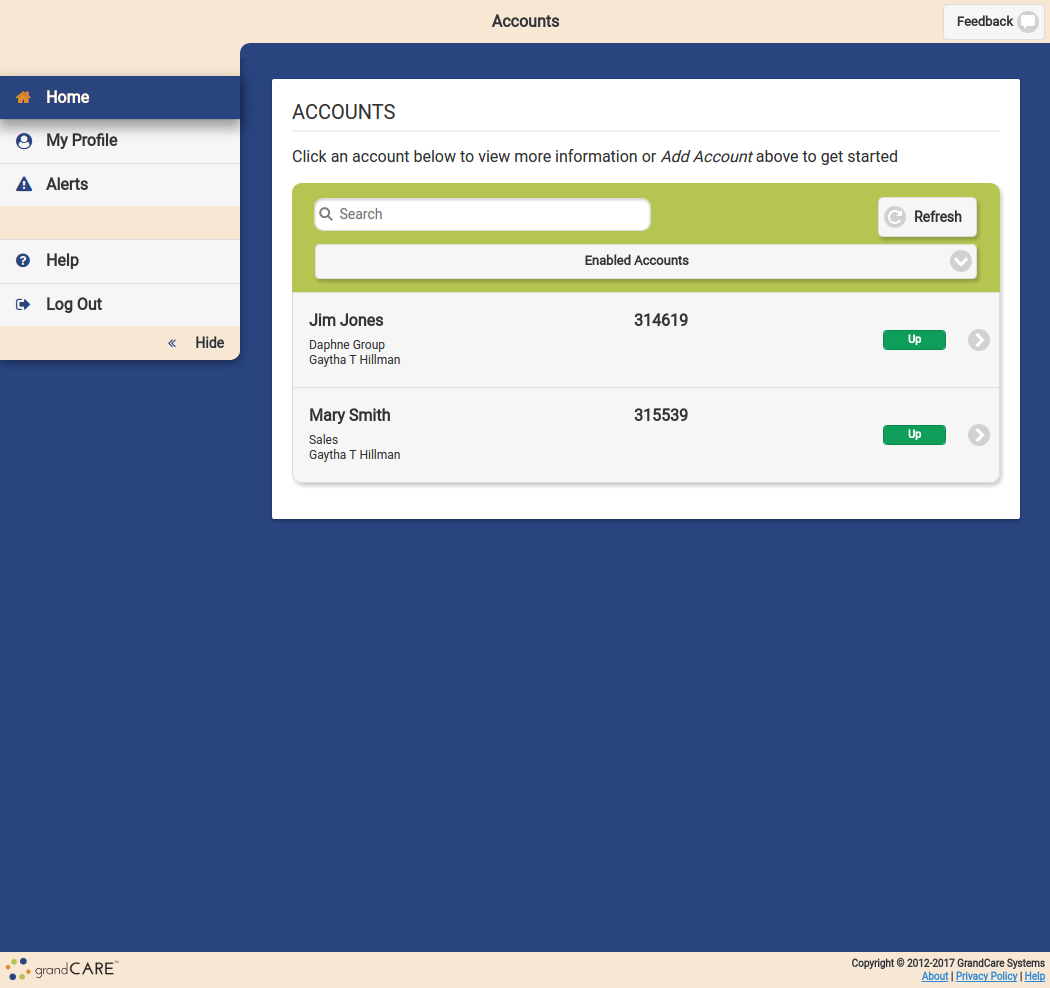Difference between revisions of "Online Care Portal"
Jump to navigation
Jump to search
m |
|||
| (54 intermediate revisions by 4 users not shown) | |||
| Line 1: | Line 1: | ||
[[File: | [[File:Multiple_Accounts.png|right|400px|thumb|frame|The Dashboard of the Online Care Portal - for an Admin-Level User]] | ||
< | __NOTOC__ | ||
<table> | |||
<tr><td valign="top">[[File:caregiverSmall.png|left|Activity Monitoring]]</td> | |||
<td> | |||
===Overview=== | |||
<br /> | |||
The Online Care Portal is the website that caregivers use to access the resident's system. Through the Care Portal, caregivers can use all the features of the system, such as viewing activity or health data, setting rules, or communicating with the resident. Because the Care Portal is web-based, it can be used on any Internet-connected device, e.g. a PC, laptop, tablet or mobile device.</td></tr> | |||
</table><br /> | |||
===Logging In=== | |||
The most important thing the Online Care Portal does is to control who has access to your loved one's system. Only authorized users can [[Logging In|log in]] to the Online Care Portal. The [[User Roles and Privileges|user's role]] determines what features are available to the user. For more information about user roles, see: | |||
:*[[User Roles and Privileges|User roles defined]] | |||
:*[[Roles and Privileges Chart|User roles and privileges chart]]<br /><br /> | |||
The features and capabilities available to each user is determined by their [[User Roles and Privileges|User roles]]. | |||
:*[[Group-Level Users|Group-Level Users - what they can do]] | |||
:*[[Account-Level Users|Account-Level Users - what they can do]] | |||
:*[[Resident-Level Users|Resident-Level Users - what they can do]]<br /><br /> | |||
===General Features=== | |||
:<big>'''System Controls'''</big><br /> | |||
::*[[Open Care Menu|Open the Care Menu]] | |||
::*[[Show Touchscreen|Show the Touchscreen]] | |||
:<big>'''Notifications'''</big><br /> | |||
::*[[Care Notes|View and Create Care Coordination Notes]] | |||
::*View System Alerts<br /><br /> | |||
===Accounts=== | |||
Each system has its own account displayed on the Online Care Portal. Each account is accessed separately making it easy for Caregivers to manage multiple systems. | |||
:*[[View Accounts|How to view account information]] | |||
:*[[Manage Account|How to manage and edit the account information]] | |||
:*[[Search Accounts|Search for accounts]] | |||
Latest revision as of 15:18, 28 July 2017
Overview
|
Logging In
The most important thing the Online Care Portal does is to control who has access to your loved one's system. Only authorized users can log in to the Online Care Portal. The user's role determines what features are available to the user. For more information about user roles, see:
The features and capabilities available to each user is determined by their User roles.
General Features
- System Controls
- Notifications
- View and Create Care Coordination Notes
- View System Alerts
Accounts
Each system has its own account displayed on the Online Care Portal. Each account is accessed separately making it easy for Caregivers to manage multiple systems.

